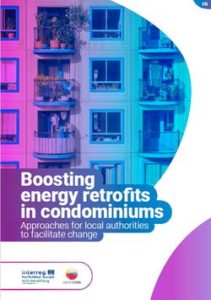Accelerating Condominium Energy Retrofitting
Nearly zero energy retrofitting in 17 condominiums
The City of Tartu participated in the Horizon2020 project SmartEnCity as a lighthouse city. The project’s main goal was the reduction of energy consumption in condominiums built during the Soviet era. There are an estimated 6 000 buildings of this construction type in Estonia. In Tartu, 17 condominiums in the city center were retrofitted within the scope of the project: All renovated condominiums are now in line with the standards of nearly zero energy buildings and are equipped with solar panels and smart energy home solutions that help monitor energy consumption. They also provide improved, high-quality living environments for residents, encouraging them to be more environmentally aware on a daily basis.
In this case study, you will learn how the City of Tartu and the Tartu Regional Energy Agency worked with residents to retrofit condominiums in order to increase energy efficiency and housing comfort.
The financing scheme
The total costs added up to about 9 million Euro. In Estonia, the average price of retrofitting condominiums is 250 €/m2. However, 350 €/m2 to 850€/m2 were set for this renovation project, as it aimed at a higher level of energy efficiency. Costs depended on the building size as well as the extent of retrofitting: Condominiums that only focused on energy retrofitting payed less than buildings that extended the renovations to improve the overall living quality.
In general, apartment associations in Estonia can benefit from financial support from KredEx, a foundation set up by the Estonian Ministry of Economic Affairs and Communications to provide financing solutions for companies as well as private individuals searching to renovate their dwellings to improve energy efficiency. To receive financial support, the concerned buildings must have been built and entered use before 1993. The KredEx support can be combined with other financial aids such as loans or subsidies. In order to obtain this financial support, renovation plans must aim at an improvement to energy class C, which equals 122kWh/m2 per year or less. In Tartu, the housing associations received a KredEx support of 40% of the total renovation costs.
In addition, the City of Tartu provided extra funding for owners and housing associations that were willing to extend renovations to reach the energy efficiency of a Nearly Zero Energy Building (energy class A, 92 kwh/m2per year or less). The city provided a subsidy of 102 €/m2. To benefit from this subsidy, apartment associations had to agree on having artwork added to the outside of their buildings. The additional costs incurred by this were also partly carried by the city. The budget was 8 000€ per building, with the city providing 5 000€ from the city budget and the housing associations covering the remaining costs. The financial aids by KredEx and the city covered about 2/3 of all renovation costs. For the remaining costs, housing associations took out loans

